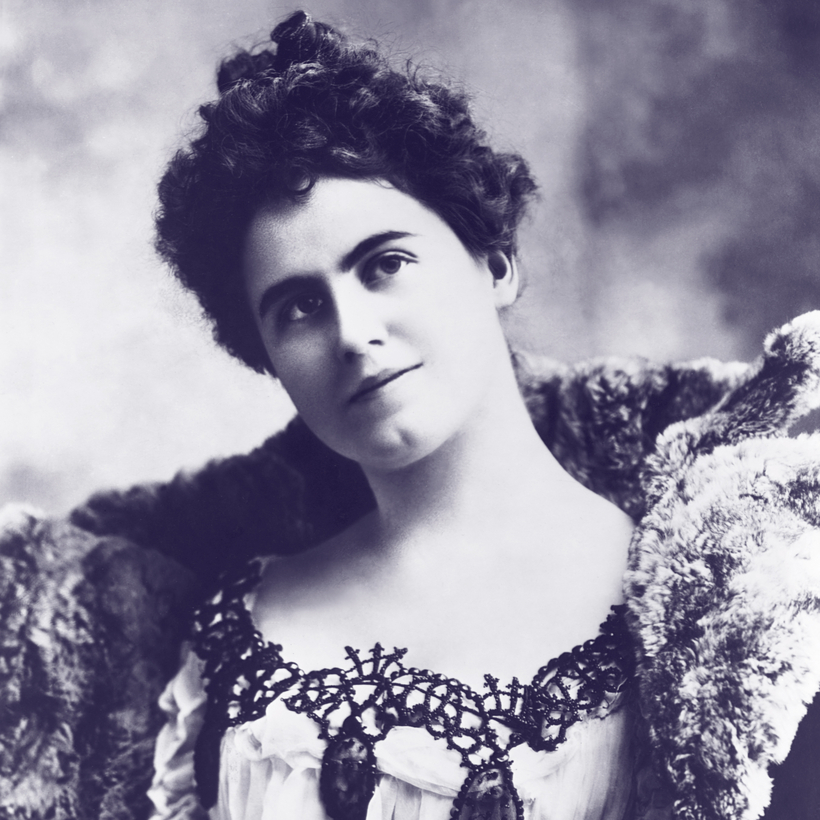Pity Edith Wilson. The one thing she really wanted was to be left alone with her husband, Woodrow, the 28th president of the United States. But a century after his death first separated the Wilsons, they are drifting ever further apart.
In June of 2020, Princeton University, which Woodrow attended as an undergraduate and where he later served as university president, removed his name from its school of public policy, citing his “racist thinking and policies.” Always hidden in plain sight, his unbounded racism—lowlights included hosting a screening of The Birth of a Nation at the White House—had become too much for an enlightened 21st-century institution to bear.
But while her husband was getting canceled, Edith was becoming a #Girlboss. Drawn to the story of the 15 months she spent effectively running the country after Woodrow’s stroke left him incapacitated, contemporary American culture has claimed her as a proto-feminist heroine. She’s been played by Rosamund Pike, in the podcast series Edith!, and by Courteney Cox, in an episode of Comedy Central’s Drunk History entitled “Edith Wilson: The First Female President.”

The divergence in the couple’s modern reputations would distress Edith no end. As Rebecca Boggs Roberts demonstrates in her carefully researched new biography, Untold Power: The Fascinating Rise and Complex Legacy of First Lady Edith Wilson, Edith disliked feminism and feminists and had little interest in amassing power. Her great wish was a quiet, comfortable post-presidential life with Woodrow—a wish that never really came to pass.
A Reluctant First Lady
Edith was 42 when she first met Wilson, in Washington in the spring of 1915, two years into his first term as the country’s 28th president. Though his first wife, Ellen, had died in the White House just seven months before, Woodrow was instantly smitten with Edith, a Southern belle born in Virginia in 1872.
In the 1890s, Edith had come to Washington, where she met and married Norman Galt, a local jeweler. After Norman’s death, in 1908—a death, Roberts notes, that takes up “about a third of a sentence” in Edith’s 1939 memoir—Edith assumed the role of stylish, sophisticated Washington widow. She favored black dresses, not as mourning gear but because they complemented her complexion.
Woodrow found her irresistible, and she encouraged his interest with the kind of unsubtle flattery that always gets male politicians going. “I … love the way you put one dear hand on mine,” she wrote to him, “while with the other you turn the pages of history.”
Still, when the president proposed marriage after a mere six-week acquaintance, Edith hesitated. She wanted Woodrow but not the White House. For a time, she said she’d marry him only if he left the presidency after a single term. Eventually she relented.
They married in her Washington home in December 1915, 11 months before Woodrow would run for re-election. Shortly thereafter she moved into the presidential mansion, where, Roberts writes, Edith “replaced Ellen’s prim twin beds with the huge bed made for Abraham Lincoln.” And she made it known that her preferred title was “Mrs. Woodrow Wilson,” not “First Lady of the United States.”
That sense of priorities—Woodrow first, country second—gave rise to Edith’s remarkable, and unconstitutional, turn as a secret quasi-president in the latter years of Woodrow’s second term. In the fall of 1919, Woodrow took gravely ill while on a cross-country train trip. On returning to Washington, he suffered a massive stroke. “He was physically almost incapacitated,” recalled Ike Hoover, the head White House usher, able to “articulate but indistinctly and think but feebly.” In other words, he was in no condition to continue serving as president.
Edith Wilson wanted Woodrow but not the White House.
But resigning, according to the doctors, would sink Woodrow’s spirits and stall his recovery—not an option as far as Edith was concerned. Instead, she constructed an elaborate ruse, convincing the Congress, the Cabinet, and the country that while recuperating behind closed doors in the White House, her husband was fully able to execute his office. To keep up the illusion, she saw to it that the president’s responsibilities were indeed carried out—by her.

Edith extended the subterfuge to her husband, soothing him on his sick bed with assurances that he and his doomed League of Nations were widely beloved by the country at large. Her act was so convincing that when the pro-Wilson, pro-League Democratic ticket was defeated in a landslide in the 1920 election, Woodrow was genuinely shocked.
Edith’s longed-for private life with her husband finally arrived when the Wilsons left the White House, in the spring of 1921. But that life was dominated by Woodrow’s infirmity, and in less than three years he was dead. Edith, meanwhile, lived until the early 1960s, her years largely devoted to promoting her husband’s posthumous reputation.
Edith’s own White House record, as Roberts’s book ably shows, is above all a testament to her fierce devotion. Whenever the real first female president finally arrives at the White House, she probably won’t gain the kind of inspiration from Edith’s story that she’ll find in, say, Eleanor Roosevelt’s. But when times get rough, she’ll be lucky to have Edith’s spirit standing watch.

Jonathan Darman is the author of Becoming FDR: The Personal Crisis That Made a President


